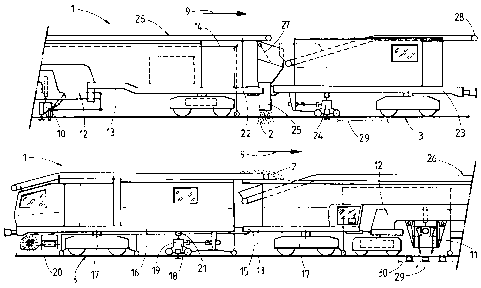Some of the information on this Web page has been provided by external sources. The Government of Canada is not responsible for the accuracy, reliability or currency of the information supplied by external sources. Users wishing to rely upon this information should consult directly with the source of the information. Content provided by external sources is not subject to official languages, privacy and accessibility requirements.
Any discrepancies in the text and image of the Claims and Abstract are due to differing posting times. Text of the Claims and Abstract are posted:
| (12) Patent: | (11) CA 2703195 |
|---|---|
| (54) English Title: | A METHOD AND MACHINE FOR CONSOLIDATION OF BALLAST OF A TRACK |
| (54) French Title: | PROCEDE ET MACHINE DE COMPACTAGE DE BALLAST DE VOIE FERREE |
| Status: | Granted and Issued |
| (51) International Patent Classification (IPC): |
|
|---|---|
| (72) Inventors : |
|
| (73) Owners : |
|
| (71) Applicants : |
|
| (74) Agent: | RICHES, MCKENZIE & HERBERT LLP |
| (74) Associate agent: | |
| (45) Issued: | 2015-05-12 |
| (86) PCT Filing Date: | 2008-10-17 |
| (87) Open to Public Inspection: | 2009-06-04 |
| Examination requested: | 2013-06-13 |
| Availability of licence: | N/A |
| Dedicated to the Public: | N/A |
| (25) Language of filing: | English |
| Patent Cooperation Treaty (PCT): | Yes |
|---|---|
| (86) PCT Filing Number: | PCT/EP2008/008797 |
| (87) International Publication Number: | WO 2009068139 |
| (85) National Entry: | 2010-04-21 |
| (30) Application Priority Data: | ||||||
|---|---|---|---|---|---|---|
|
Consolidation of ballast (2) of a track (3) is carried out in two steps, after
cleaning by means of a cleaning machine (4). To that end, cleaned ballast is
discharged, thus forming a first ballast layer (29). The track (3), laid upon
the
same, is set in transverse oscillations by a front stabilising unit (24), and
thus
the first ballast layer (29) is consolidated. With the aid of a second chute
(25),
a second ballast layer (30) is formed which is subsequently consolidated by
means of a rear stabilising unit (18).
La présente invention concerne le compactage de ballast (2) d'une voie ferrée (3), compactage qui a lieu après un nettoyage en deux étapes effectué par une machine de nettoyage (4). A cette fin, du ballast nettoyé est éjecté puis utilisé pour former une première couche de ballast (29). La voie ferrée (3) posée sur cette couche est déplacée selon des oscillations transversales par un module de stabilisation avant (24) et compacte ainsi la première couche de ballast (29). Une seconde goulotte (25) permet de former une seconde couche de ballast (30) qui est ensuite compactée par un module de stabilisation arrière (18).
Note: Claims are shown in the official language in which they were submitted.
Note: Descriptions are shown in the official language in which they were submitted.

2024-08-01:As part of the Next Generation Patents (NGP) transition, the Canadian Patents Database (CPD) now contains a more detailed Event History, which replicates the Event Log of our new back-office solution.
Please note that "Inactive:" events refers to events no longer in use in our new back-office solution.
For a clearer understanding of the status of the application/patent presented on this page, the site Disclaimer , as well as the definitions for Patent , Event History , Maintenance Fee and Payment History should be consulted.
| Description | Date |
|---|---|
| Maintenance Request Received | 2021-08-12 |
| Common Representative Appointed | 2019-10-30 |
| Common Representative Appointed | 2019-10-30 |
| Grant by Issuance | 2015-05-12 |
| Inactive: Cover page published | 2015-05-11 |
| Inactive: Reply to s.37 Rules - PCT | 2015-02-20 |
| Pre-grant | 2015-02-20 |
| Inactive: Final fee received | 2015-02-20 |
| Notice of Allowance is Issued | 2015-01-30 |
| Letter Sent | 2015-01-30 |
| Notice of Allowance is Issued | 2015-01-30 |
| Inactive: QS passed | 2015-01-19 |
| Inactive: Approved for allowance (AFA) | 2015-01-19 |
| Amendment Received - Voluntary Amendment | 2014-12-12 |
| Maintenance Request Received | 2014-08-20 |
| Inactive: S.30(2) Rules - Examiner requisition | 2014-07-30 |
| Inactive: Report - No QC | 2014-07-24 |
| Maintenance Request Received | 2013-08-08 |
| Letter Sent | 2013-06-28 |
| Request for Examination Received | 2013-06-13 |
| Request for Examination Requirements Determined Compliant | 2013-06-13 |
| All Requirements for Examination Determined Compliant | 2013-06-13 |
| Inactive: Cover page published | 2010-06-15 |
| Inactive: Notice - National entry - No RFE | 2010-06-09 |
| Inactive: First IPC assigned | 2010-06-08 |
| Inactive: IPC assigned | 2010-06-08 |
| Inactive: IPC assigned | 2010-06-08 |
| Application Received - PCT | 2010-06-08 |
| National Entry Requirements Determined Compliant | 2010-04-21 |
| Application Published (Open to Public Inspection) | 2009-06-04 |
There is no abandonment history.
The last payment was received on 2014-08-20
Note : If the full payment has not been received on or before the date indicated, a further fee may be required which may be one of the following
Please refer to the CIPO Patent Fees web page to see all current fee amounts.
Note: Records showing the ownership history in alphabetical order.
| Current Owners on Record |
|---|
| FRANZ PLASSER BAHNBAUMASCHINEN-INDUSTRIEGESELLSCHAFT MBH |
| Past Owners on Record |
|---|
| HERBERT WOERGOETTER |
| JOSEF THEURER |